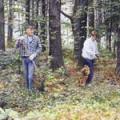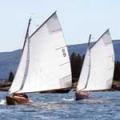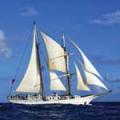Three Futures for the Gulf of Maine
 The waters of the Gulf of Maine are some of the fastest-warming in the world. From sea-level rise to ocean acidification, conditions are changing. But what does that mean and what will the Gulf look like in 50 years? Charting potential future scenarios is key to answering those questions. Photograph by Polly Saltonstall
The waters of the Gulf of Maine are some of the fastest-warming in the world. From sea-level rise to ocean acidification, conditions are changing. But what does that mean and what will the Gulf look like in 50 years? Charting potential future scenarios is key to answering those questions. Photograph by Polly Saltonstall
Renowned ocean scientist Jane Lubchenco was recently asked in an interview whether the ocean is doomed. Admittedly, it’s a heavy interview question, but it’s one that’s coming up more and more often. Plastic pollution, climate change, fishery collapses, and so on—are we pushing the ocean beyond its breaking point? Or is there enough resilience in the ocean and enough flexibility in our society to maintain a healthy ocean?
Dr. Lubchenco responded that the ocean is too important for us to allow it to be doomed—it’s too integral to the planet’s life support. Still, the ocean is changing all around us. If we can’t answer whether the ocean is doomed, we should still ask what its future looks like.
The Gulf of Maine, as it turns out, is a compelling place to dig into these questions. So much is changing so rapidly. In my work as an ocean forecaster, I try to figure out what the future looks like for places such as the Gulf of Maine. The first step toward shaping the future that we want is to chart the potential futures that might come about. I can tell you what the collective science says about the future of Maine’s waters. But like anyone who claims to know the future, I’m mostly going to talk about the past.
Some years ago, I started visiting dozens of venues around Maine—churches, community centers, libraries, and classrooms. My hope was to tell the story of what climate change means for Maine at a local scale—not what it means for polar bears or coral reefs, but what the specific consequences will be to whatever town I was visiting on that day. I hoped showing up in person, and letting people talk with a normal (if perhaps nerdy) scientist might cut through some of the politics and headlines that swirl around climate change.
Yes, occasionally there is a climate denier who asks about volcanoes or cosmic rays. And I do sometimes run into what the great climate writer Mary Annaïse Heglar calls “climate de-nihilists”—those who, in their dismissive privilege, relish the doomed fate of humankind. But we Mainers are known for our pragmatism. Most of the people I’ve encountered have a good understanding of the general facts about climate change and want pragmatic answers to pragmatic questions—what are the particulars of what’s happening here? Which exact roads will flood, or how bad will the deer ticks get? Which fish will we be able to catch?
 Data on the Gulf of Maine show conditions that are changing more rapidly than other parts of the ocean. Long-term datasets inform models that can provide predictions on what the future of the ocean will look like. This image shows concentrations of surface phytoplankton chlorophyll, which is used to estimate the amount of phytoplankton in the water. Photo courtesy Bigelow Laboratory for Ocean Sciences
Data on the Gulf of Maine show conditions that are changing more rapidly than other parts of the ocean. Long-term datasets inform models that can provide predictions on what the future of the ocean will look like. This image shows concentrations of surface phytoplankton chlorophyll, which is used to estimate the amount of phytoplankton in the water. Photo courtesy Bigelow Laboratory for Ocean Sciences
Anyone who has been following news of the Gulf of Maine over the years knows by now that its waters are some of the fastest-warming in the world. The rapid warming was first noted 10 years ago, during what was determined to be a historic marine heat wave that lasted more than a year. Since then, what seemed like a clear narrative has become cloudier. On one day, you might read that the lobster industry is doomed to collapse in the throes of climate change. On the next day, the headlines are abuzz with record lobster profits. Some years, it seems that jellyfish are taking over, and then the story disappears without a trace.
From whales to sea level rise to ocean acidification to puffin colonies, we know conditions are changing. All of these topics are nuanced and complex. With the confusing array of headlines out there, many people are left with their heads spinning. Where, exactly, are we headed?
Mary Shelley once wrote, “Nothing is so painful to the human mind as a great and sudden change.” It’s difficult to understand change when in the midst of it. When confronted with this magnitude of change, people react in many different ways, from denial to despair. In times of crisis, I find that it helps to put things into historical perspective.
To begin with, in all likelihood, the world’s oceans will outlast humanity. Whatever we might do to the planet—climate change, mass extinctions, even nuclear winter—the oceans will survive. If humankind inexplicably turned all of our resource and ingenuity toward wiping the oceans from the face of the Earth, I’m not convinced we could do it. The ocean has been through asteroid impacts that boiled its waters and blotted out the sun, into and out of ice ages, and under an atmosphere that for millennia would have been toxic to humans. Still it has persisted, and still it flourishes with life.
From this cosmic point of view, the ocean is not doomed.
If descriptions of an asteroid boiling the ocean are not that comforting, we can take a look at more recent times. This spot in midcoast Maine where I’m currently writing was once covered with a miles-thick sheet of ice—and it wasn’t that long ago. At the time when the most recent ice sheet was retreating from Maine, humans were already forming settlements around the world, some in places that would eventually morph into today’s modern cities including Aleppo and Damascus. Meanwhile, furry mammoth-like beasts called mastodons roamed across what is now the rich offshore fishing grounds of Georges Bank, which back then was pasture. We know this because mastodon tusks have been hauled up in fishing nets.
The Gulf of Maine, at the time pre-Aleppo was being settled, would have been very different from today. Its waters would have been fresher due to the melting of the ice sheet and being almost totally cut off from the open ocean. There wouldn’t have been the colossal tides that these shores are now known for, and the sea life would have been completely different.
Even in the intervening centuries, this has been a place of change—a place that, if compared to how we know the Gulf of Maine now, would be scarcely recognizable. Take herring gulls, fondly referred to today as “rats of the sky.” It’s hard to picture coastal Maine without them. But a little over a century ago, the species had been pushed to the brink of extinction largely by the millinery craft because people wanted to walk around with feathery hats. It was partly thanks to conservation efforts like the Migratory Bird Convention that we are lucky to have so many herring gulls decorating our skies (and dumps) today.
If we were to hop back through time and visit the coast of Maine through the centuries, we’d see many different incarnations. At times we’d see coastal waters so dense with herring that tuna—now one of the most valuable fish on the market—was considered bycatch. At other times, we’d see fish swimming up our rivers by the billions. Imagine swordfish in Portland Harbor, or shoals of cod so dense as to slow the passage of ships.
All of this is to say that the Gulf of Maine is not as timeless and immutable as it might appear on a postcard of Pemaquid Point. Things have been changing continuously over the millennia. Some of these changes have been traumatic to communities, like collapses of fisheries, while others have been gradual.
None of this should undermine the significance of the changes that are happening now. Changes are coming faster and more frequently, and we expect that pattern to continue. But it’s important to remember as we look to the future that it’s unrealistic to think about conservation or preservation in some idealized, “natural” permanent state. Because the Gulf of Maine is so young, it has more or less been in a constant state of change.
Before we jump to the future, let’s make one more stop to examine the changes that are happening now. I’d like to take you back to the marine heat wave that woke up the scientific community in 2012. Every year, scientists from all around the Gulf of Maine—from Cape Cod to Nova Scotia—gather to geek out about the goings-on in the Gulf at a meeting called by the awkward acronym “RARGOM.” At the 2013 RARGOM meeting, nobody could talk of anything but the 2012 marine heat wave.
 A water sample taken from Boothbay Harbor will be used in research to extract genetic information from microbes in the Gulf of Maine. Every drop/vial of water contains a vast amount of data that can give scientists insight into the changing oceans. Photo by Ramunas Stepanauskas, Bigelow Laboratory
A water sample taken from Boothbay Harbor will be used in research to extract genetic information from microbes in the Gulf of Maine. Every drop/vial of water contains a vast amount of data that can give scientists insight into the changing oceans. Photo by Ramunas Stepanauskas, Bigelow Laboratory
The first speaker gave a case study in dramatic science presentations. He showed a graph of coastal water temperatures dating back to the 1600s. It is possible to recover that data from the shells of quahogs. Their shells grow in increments, a bit like the rings of a tree, with each ring recording what the climate is like at the time. The technique could, in principle, tell us what the water conditions were like on the year when the Titanic sank. Over the centuries, the temperatures in the graph went up and down, lining up with known events of climatic significance, such as major volcanic eruptions. The speaker then drew a new point on the graph, showing 2012. It was off the chart, warmer than anything in his record that covered hundreds of years. There we were in 2013 already dealing with temperatures that weren’t supposed to arrive until the end of the century. Each subsequent speaker told how the warm waters had affected their part of the Gulf of Maine. One dramatic graph, statistic, and diagram after the next showed the proliferation of comb jellies, the die-off of puffin chicks, the appearances of seahorses, black sea bass, longfin squid, and, somewhat inexplicably, Arctic bowhead whales. Reflecting on that year, now a decade later, I remember it as the last year we could find northern shrimp at fish markets, or walk along a shoreline wallpapered with blue mussels. Things changed in the blink of an eye.
There’s an idea called “shifting baselines,” introduced to ocean science by Dr. Daniel Pauly. The basic idea is that when we look at the ocean today, we think about all of the things we want to conserve, forgetting what we’ve already lost over the preceding decades. In whatever time we are in, we take today as our baseline. We can still enjoy the ocean today, sail on its waves, eat its fish, view its wildlife, and feel like we have a healthy ocean. But next to the oceans of yesterday, when our shores overflowed with life, the coast of Maine is almost unrecognizable. Even 10 years ago, just before the marine heat wave hit, things were very different.
So now we come to the question of the future. What is the future ocean that will make us forget what we’re used to today? Will we still see it as healthy, or dying? To what degree can we predict, or even shape, what is coming? It’s impossible to know for sure, of course, but I did claim to be an ocean forecaster a few paragraphs ago. There is a lot to unpack in this field of science, but I’ve broken it down here into three possible futures for the Gulf of Maine.
Future 1: Business as Usual
A century and a half ago, the science fiction writer Jules Verne speculated on the changing ocean, making his own forecast: “crowded with jellyfish, squid, and other devilfish, the oceans will have become huge centers of infection.” While jellyfish don’t “infect” the ocean (they just live there), Verne was playing forward the consequences of the intense extraction of sea life that was happening at the time.
This is what climate scientists call the “Business as Usual” scenario: take the changes that are happening now and extrapolate them into the future. There are plenty of attempts in the scientific literature to predict what the ocean will look like in 50 or 100 years using similar methods. Usually these studies focus on one species or a group of related species.
To credit Verne’s prediction, one study did reveal that cephalopods—that is, squids, octopuses, and cuttlefish (which the study refers to as “voracious and adaptable predators”)—are faring much better in the changing ocean and could proliferate in a warmer world. Another collection of studies notes the global rise of jellyfish, often arguing that human influences are leading toward an ocean dominated by jellyfish. Yet another collection of studies warns of the possible global rise of toxic algae. Put all of these studies together, and you get something like what Verne predicted—a warm, acidic, low-oxygen soup filled with a surprising diversity of jellyfish, squid, and plastic pollution, more common than fish, plus toxic algae and flooded cities wherever the land meets the sea.
This type of predictive method was recently applied to the Gulf of Maine. In a 10-year follow-up to that original meeting about the 2012 heat wave, scientists from around the region got together (in another RARGOM meeting) to discuss what the Gulf of Maine could look like by the year 2050. Among other topics, the studies outlined the general warming trends, changing currents, projections for sea level rise and its effect on infrastructure, and ocean acidification along the Maine coast. Regarding lobster and whale populations, these are projected to change too. In the long term, many of the good whale feeding areas are predicted to move into Canadian waters. Lobsters are an interesting case, teetering on the edge—the “Business as Usual” scenarios mostly warm them out of coastal Maine, but with some reductions in emissions, they could hang on, especially downeast. The outlook for seabirds like puffins and razorbills was more uncertain, with evidence pointing in multiple directions, reflecting the challenge of trying to forecast something as complicated as a bird colony.
Some of the findings were surprising to me. We’ve heard that sea level is rising, for example, due to melting of ice and thermal expansion (water expands when it warms). On top of this, though, we should expect 4-8 inches of additional sea level rise due to a change in the position of the Gulf Stream. That’s a significant prediction when it comes to rebuilding our roads and bridges.
Some of the predictions for ocean acidification were surprising, as well. As the ocean absorbs carbon dioxide from fossil fuel emissions, it is becoming more acidic, potentially dissolving the shells of some sea life. The good news for the Gulf of Maine is that the warming works to slow the acidification process. The bad news is that deeper waters near the bottom—where many shellfish live—are projected to feel the effects of acidification even more than global models had previously predicted.
The collection of studies was a remarkable, collaborative effort among scientists to paint a picture of a particular future, from the physics to the fish. But the question then becomes: is this future set in stone, or can we change course?
Future 2: The Ghost of Climate Yet to Come
The “Business as Usual” forecasts aren’t necessarily meant to be true predictions in the vein of a weather forecast. They are more of a call to action. It’s a bit like Dickens’s character The Ghost of Christmas Yet to Come, who shows Ebenezer Scrooge his lonely future funeral. Scrooge sees this forecast and asks in desperation if there is still time to change—and, of course, there is.
This type of forecasting is called “reflexive prediction”—where the prediction itself changes the outcome. The “forecast” is a warning that comes true if ignored, but, if acted on, can lead to a reversal of the prediction. Reflexive predictions, if not used wisely, can lead to stock market crashes, flipped elections, and cosmic time-travel paradoxes. But if used wisely, they can avoid the worst of climate change.
The scenarios outlined in “Future 1” are like the Ghosts of Climate Yet to Come. There are solid calculations indicating that these unsettling futures are likely to come to pass if we don’t change our path. But those calculations leave open the possibility that we can change course. As Scrooge pleads, “Assure me that I yet may change these shadows you have shown me, by an altered life!” What can we do, then, in the face of the warnings?
The solution breaks down into two components, referred to as mitigation and adaptation. Mitigation means treating the source of the problem—reducing the greenhouse gas emissions. This is akin to a smoker quitting smoking altogether in the face of impending health problems. Adaptation, on the other hand, means acknowledging that change is happening, and trying to prepare and change with it. This is akin to the smoker trying to treat the symptoms.
Mitigation has been an elusive goal, but there are people trying. The Paris Agreement is one example, where almost all of the nations in the world agreed to certain goals of reducing greenhouse gas emissions. The uphill climb toward getting the world to agree to climate mitigation is ongoing. But there are local consequences for the Gulf of Maine. Cutting down on fossil fuels generally means replacing them with renewable energy sources. The Gulf of Maine has an abundance of renewable energy in the form of offshore wind. A future where climate change mitigation is taken seriously is one that probably includes a Gulf of Maine where offshore wind turbines are peppered among other marine activities, like fishing and aquaculture.
When it comes to adaptation, the solutions are more piecemeal. Each adaptation solution addresses a particular climate symptom, of which there are many. For example, sea level rise means rebuilding coastal infrastructure with the future sea level, not the current sea level, in mind. With the ocean changing in so many ways, the list of potential adaptations is long, and it’s something that many government agencies, towns, and businesses are trying to grapple with.
One of my favorite adaptations is the expansion of kelp farming—or sea vegetables. Kelp is the sort of crop where a grower doesn’t have to worry about drought or nutrient shortages (both consequences of changing climate). The growing of kelp, if done right, can counteract ocean acidification and provide healthy ocean habitat, and it’s extremely healthy (call me, Big Kelp). The downside, of course, is that people aren’t lining up to pay $40 for a kelp roll. Yet.
Future 3: Permanent, Intolerable Uncertainty
So far we’ve got two futures for the Gulf of Maine—one where the changes we’ve set in motion continue, unabated, leading to an unrecognizable and perhaps inhospitable ocean, and another where we’ve stepped up globally and locally to slow and adapt to the changes, one solution at a time. I’ve painted this as a contrast, but there is a lot of space in between these two futures. There are scenarios where we achieve some success and preserve some features of this coastal ecosystem, but lose out on others.
I suspect that there is a third possible future, but here the tea leaves are hazy. This future involves rethinking our relationship with the Gulf of Maine and with the natural world.
A lot of our conservation efforts are motivated by what are called “ecosystem services”—that is, the services that ecosystems provide to the benefit of humans. Often cited are food, energy, clean drinking water, a stable climate, medicinal compounds, and so on. If we are too destructive to the environment, the logic goes, we lose these services, and humanity suffers. Ergo, we conserve and preserve.
The idea of ecosystem services has been a way to get people to listen to environmental concerns. Keeping a healthy ocean is justified insofar as it provides a service to humans. But it’s a tenuous basis for a relationship. Imagine if marriage counselors advised working on healthy partnerships in order to maintain “spousal services” (washing dishes, mowing the lawn, grocery shopping). If you don’t treat your spouse well, you might lose these essential spousal services.
A new approach could involve moving away from the current servant-based relationship with the ocean. Scholars and thinkers have proposed alternate visions, ranging from a networked global system of ocean monitoring devices steered by artificial intelligence that links humankind with the natural world, to the simpler but probably more useful idea of coming to terms with our limited ability to control and manage nature. My intuition tells me that there is a way to think of the ocean as more of a partner than a resource—to listen to and work together with the ocean. But I don’t know exactly how we can do it, or if we even have time. I do know that the fate of humanity is tied to the fate of the ocean and that things are changing rapidly—probably more rapidly than they have in quite a long time. The science of prediction can only tell us so much, and from there we have to feel our way forward along the hazy path that is laid out. In the words of Ursula K. Le Guin, “The only thing that makes life possible is permanent, intolerable uncertainty: not knowing what comes next.”
Dr. Nicholas R. Record is a Senior Research Scientist at Bigelow Laboratory for Ocean Sciences.
Read more about ongoing research projects and studies at www.bigelow.org.
Related Articles
Share this article:
2023 Maine Boat & Home Show

Join Us for the Maine Boat & Home Show!
Art, Artisans, Food, Fun & Boats, Boats, Boats
August 11 - 13, 2023 | On the waterfront, Rockland, Maine
Click here to pre-order your tickets.
Show is produced by Maine Boats, Homes & Harbors magazine.















